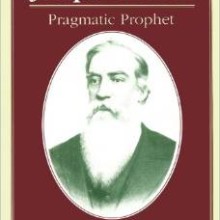This is the first volume of a two volume history of the Reorganized Church of Jesus Christ of Latter Day Saints (now called the Community of Christ), written by the former World Church Historian Richard P. Howard. As such it is court history in every sense of the word. The author seeks to cast a sheen of positiveness throughout, despite some very specific areas that cause difficulty in Mormon history. That said, there are some worthy sections of he book, which is more a collection of essays that a unified historical study.
For example, Howard offers a pointed discussion of the church in Kirtland, Ohio, between 1831 and 1838, suggesting that the RLDS interpretation of Kirtland as a prototype of “moderate Mormonism” and therefore the model for the Reorganization as it emerged in the 1850s and 1860s, is an idealized image. Howard notes, “RLDS ‘defenders of the faith’ have too long portrayed the Kirtland Saints of the 1830s as ‘larger than life.’ The time has come to relieve ourselves and our ancestors of such an unfair burden. The task is neither more nor less than trying to discern something of Kirtland’s truth.” He calls for, but does not himself deliver, a fundamental reinterpretation of the Kirtland experience. Instead, he relates the same basic commentary that has been taught for more than twenty years.
For example, much of the information on the development of the scriptural record that Howard includes in the Kirtland chapter is drawn from research more than a generation old. Howard’s discussion of the critically important Kirtland Safety Society anti-Bank-ing Company, moreover, is simplistic and apologetic. Consisting of only two paragraphs, this section fails to explain satisfactorily the Kirtland economy and the Mormon desire for a bank, omits details of the effort to charter and run the bank, assigns responsibility for the bank failure solely to the Panic of 1837 with no more than a sentence’s worth of discussion, and passes off the negative reaction to the bank with a simple, “Because Joseph was instrumental in the venture, he and other church leaders received severe criticism for the bank’s demise.”
Likewise, Roward Howard’s discussion of plural marriage in the early history of the Mormon church is less than satisfactory. Assignment of responsibility for the origination of the doctrine, with all of its sexual impropriety overtones, has been hotly contested. Until the early 1980s the Reorganized Church, the second largest of the Mormon factions, officially denied that Joseph Smith Jr. had been the author of plural marriage and asserted that it had been started by Brigham Young and was evidence of apostasy. This began to change in a fundamental way only after the 1983 publication of an article by Richard Howard that viewed plural marriage as something that arose in Nauvoo as an historical accident which grew like topsy near and immediately after the death of Joseph Smith Jr. The author repeats this interpretation here, as misguided as it is because of its conservatism and inability to deal with Joseph Smith’s indiscretions that came as early as the 1830s.
Overall, this is a worthwhile but flawed collection of essays on several aspects of the history of the early church from its origins in 1830 through the Joseph Smith Jr. era, to the reorganization of the church in the 1850s and the accession of Joseph Smith III in 1860.
Sale!
The Church Through the Years: Rlds Beginnings, to 1860: 001 Hardcover – March 1, 1992 by Richard P. Howard (Author)
Original price was: $45.00.$37.00Current price is: $37.00.
Roger D. Launius
5 stars out of Five : An interesting Collection of Historical Essays.
Reviewed in the United States on February 29, 2004
Description
Product details
- Publisher : Herald Pub House; 0 edition (March 1, 1992)
- Language : English
- ISBN-10 : 0830905561
- ISBN-13 : 978-0830905560
- Item Weight : 1.35 pounds
- Dimensions : 6 x 1 x 8.5 inches
- Best Sellers Rank: #2,695,104 in Books (See Top 100 in Books)
- #4,247 in Mormonism




